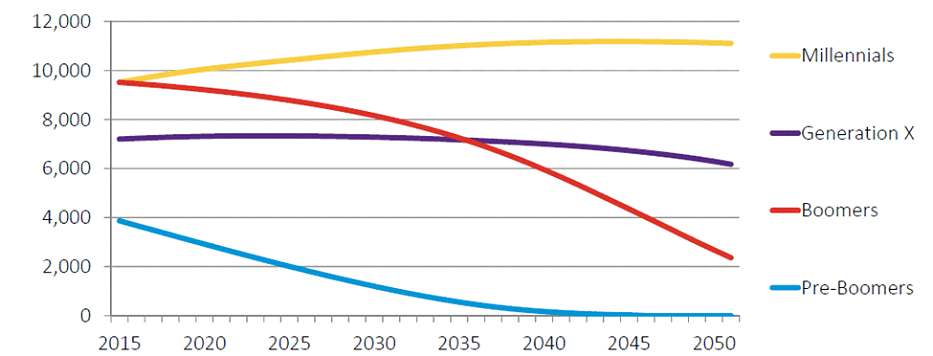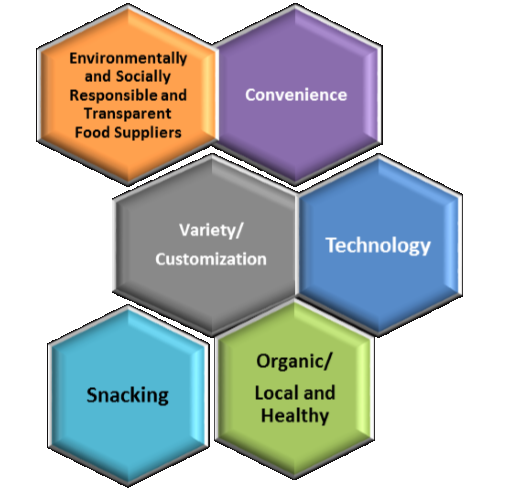| | Introduction | Millennials as a segment of the Canadian population | Millennial preferences and values surrounding food | What does this all mean? | Sources
,
Introduction
;
One of the largest generations in history is moving into its prime spending years. Millennials are poised to reshape the economy; their unique experiences will change the ways we buy and sell, prompting companies to examine how they do business for decades to come. In this issue, we provide an overview of Millennials and highlight the food habits and preferences within this group.
Millennials as a Segment of the Canadian Population
We keep hearing the term “Millennials” and how significant a segment of the population they represent.
So….who are these Millennials and where do they fit into the population?
The following table illustrates various generations and their associated attributes. Globally, Millennials make up around one third of the world’s population. As a group, they’re more ethnically diverse and well educated than any previous generation. In 2015 Millennials were between 15-34 years old and totalled 9.5 million in Canada. Millennials surpassed other generations in 2015 and comprised the largest portion of the labour force.
Table 1: Generations in Canada 2015

Source: Stats Canada (populations) and Environic (households)
According to Statistics Canada, and as illustrated in the chart below, Millennials are projected to increase in population to 2050 while the remaining segments of the population will experience a significant downturn. This means that the preferences of this generation will have a strong impact on the food industry for many years to come. Understanding this unique group and their eating habits can enhance the competitiveness of Alberta’s agri-food industry.
Chart 1: Projected Population by Generaion ( thousnds) Canada 
Source: Statistics Canada, Medium Projection
Millennial Preferences and Values Surrounding Food
Due to the wide age range, not all Millennials value the same attributes when making food choices. However,
according to recent studies the following values and preferences are shared by many. As illustrated in Figure 1, Millennials are environmentally and socially conscious and value transparency in company business. Therefore, they base their purchasing decisions on food that has been raised sustainably and ethically by agri-food businesses that are open and transparent about their operations. Millennials value local and organic food.
They don’t like to spend too much money but they will pay more for organic and local food as they value supporting their community and what they deem to be healthy. Millennials enjoy snacking and sometimes replace traditional meals with snacks. Millennials enjoy variety and value the experience of trying new and exotic food. Technology plays a key role in Millennials’ lives and they often use apps and social media to hear about and communicate about food. In addition, Millennials value convenience and may choose to go out for supper rather than prepare a meal at home.
Figure 1: Millennial Preferences and Values Surrounding Food

In addition to those noted above, further details regarding Millennials’ values and preferences surrounding food follow:
Environmentally and socially responsible and transparent – Eighty per cent of Millennials want to know more about how the food they buy was grown or processed. Millennials are interested in the story behind their food and are looking to learn more about what’s in it and how it’s made.
Transparency in business operations is important to Millennials. Companies who are open about their business practices allow Millennials to decide whether a company is operating according to their personal values. In the food industry it is important that companies can trace the source of ingredients used in their products to ensure they are safe, produced sustainably, and with the highest quality standards.
Convenience - Convenience is often a key consideration in food purchases for Millennials. This is reflected in the greater use of frozen meals and other easy-to prepare products purchased by Millennials. Millennials are also spending more of their food budget, 44 per cent, on dining out than ever before.
Variety/customization - Millennials want variety and diverse flavors as they come from various ethnic backgrounds. According to a recent study 40 per cent of Millennials order something different every time they visit a restaurant. Millennials want food items that are fresh, creative and made just for them.
Millennials may be largely defined by their individualism, an attribute that extends to their food choices and demand for customization. For the deli and prepared food industry, variety and meal customization represent a major opportunity, with an increasing number of stores mimicking restaurants and stations where consumers can customize their food.
Technology/social media - Technology plays a key role in the lives of Millennials who often utilize social media as a tool to find information about food and restaurants as well as to tell others about their food experiences and to share photos of their meals. According to a recent study, one quarter of Millennials indicated a high interest in online shopping if their regular grocery store offered it. According to the same study, 41 per cent of Millennials use mobile shopping apps and 64 per cent use an app because it saves them money.
Snacking - Millennials are snacking more than any other generation. According to trend watchers, 35 per cent of meals eaten by Millennials are snacks where foods traditionally served at breakfast, lunch and dinner are combined. Millennials are demanding more complex, bold and spicy profiles in their snacks.
Organic/local - Millennials lead the way in favoring organic ingredients, and products that are locally grown. Thirty per cent of Millennials eat certified organic food. Millennial parents seek out organic because they value knowing how their food is grown and produced, and they are committed to supporting a food system that they feel sustains and nurtures the environment. Millennials also like to support their community and purchasing local food contributes to this pursuit.
Healthy - Millennials’ definition of "healthy" is totally different from previous generations. While previous generations counted calories, Millennials care more about food being fresh, less processed and with fewer artificial ingredients.
What Does this all Mean?
- Alberta producers and food processors may gain increased market share from Millennials by marketing their sustainability practices and ethical business practices as Millennials consider these practices when making purchasing decisions.
- Alberta producers and food processors should also ensure that their supply chain follows environmental and ethical standards to potentially gain Millennial market-share.
- There are opportunities for Alberta’s local and organic food industries to capitalize on the Millennials’ demand for food produced according to these attributes.
- Utilizing technology and social media to market company products and values can help to reach the tech-savvy Millennials.
- Snacking is important to Millennials and spicy and exotic flavoured snacks offer potential market opportunities.
- Offering product variety and meal customization represents a major opportunity for Alberta food processors to attract Millennials who value variety and individualism.
Sources:
- DSM. 2016. Strategic Nutrition for Millennials - Part 1
- Environics Analytics. Millennials: The Newest, Biggest, most Diverse Target Market.
- Food Institute. 2016. Analysis of the United States Department of Agriculture’s food expenditure data from 2014.
- Food PackagingLabels.net. How Are Millennials Changing the Food Scene?
- Food Processing. 2016.
- Millennial Marketing.
- Nielsen. 2014. Millennials: Breaking the Myths.
|
|